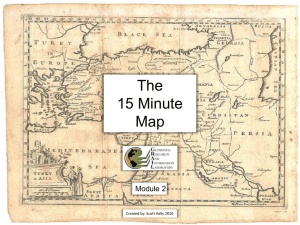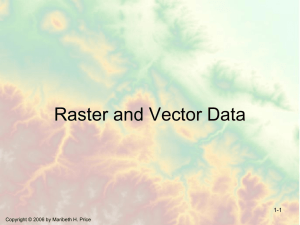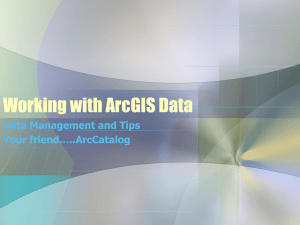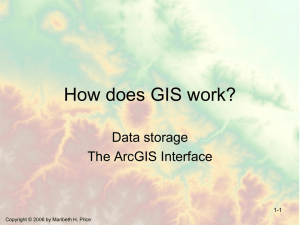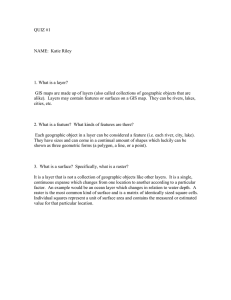Map Scale, Resolution and Data Models
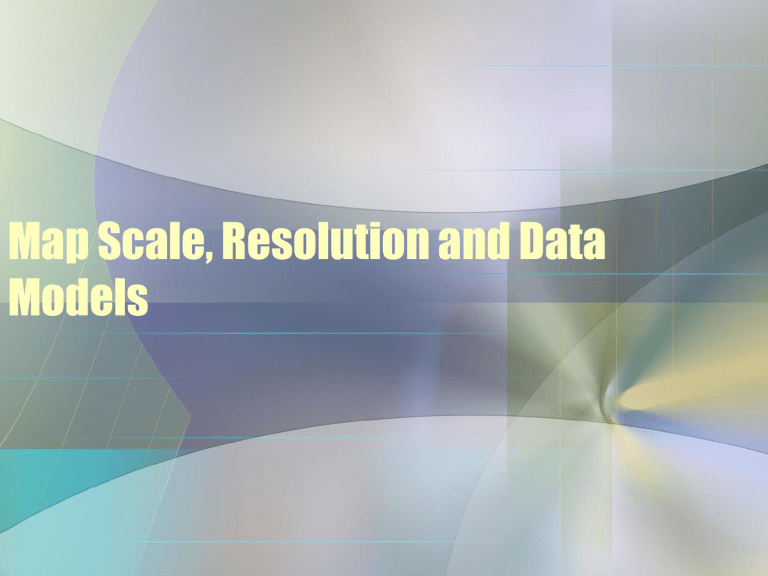
Map Scale, Resolution and Data
Models
Components of a GIS Map
• Maps can be displayed at various scales
– Scale - the relationship between the size of features on a map and the size of the corresponding places in the real world
• Scale is most commonly expressed as a ratio
– 1:100,000 or 1/100,000
• Verbal
– One inch represents 2,000 feet (1:24,000)
– One cm represents 20 km (1:2,000,000)
Map scale
• Ratio of distance on the map to distance on the ground
• Dimensionless: cm or inches or mm…
1 cm on map = 100,000 cm on ground
Copyright © 2006 by Maribeth H.
Price
Talking about map scale
• A large denominator gives a small fraction
a small scale map.
It shows a large area.
1
--------
50,000,000
1
--------
500,000 • A small denominator gives a larger fraction
a large scale map.
It shows a small area.
1
--------
5,000
Copyright © 2006 by Maribeth H.
Price
Large scale vs. Small scale
•Large scale maps represent smaller areas and thereby show greater detail
–Typically large scale maps > 1:24,000
•Small scale maps represent larger areas with less spatial resolution
–Typically small scale maps < 1:500,000
•Typical scales
–Metric
•1:10,000 or 1:25,000
•1:50,000
•1:100,000
–English System:
•1:9,600 (one inch represents 800 feet)
•1:24,000 (one inch represents 2000 feet)
•1:62,500 (one inch represents (slightly less than one mile)
Map Scale
Map Scale
Digital vs original scale
• Once in GIS data may be displayed at any scale, BUT
• Original scale of the map does impact the precision and accuracy of the data.
You should not display or analyze data at scales very different from the original source data.
Copyright © 2006 by Maribeth H.
Price
Original scale
1:100,000
Original scale
1:10 million
Units
• The cursor position on the screen may be read in several different types of units.
• Map units are determined by the x-y coordinates stored in the data file.
– Usually they are in degrees, feet, or meters
• Display units can be set by the user, so that the coordinates may be viewed in any desired unit, such as miles.
• Page units show the location on the map page layout, usually in inches or cm.
Copyright © 2006 by Maribeth H.
Price
Scale bar shows current scale as you zoom in/out
Set map units and display units in layer properties
Position bar shows current location of cursor
Display units
Copyright © 2006 by Maribeth H.
Price
2-9
Page units
Display scale
Visible range set less than or greater than a specific scale.
Helps avoid clutter.
Copyright © 2006 by Maribeth H. Price
1:325,582
1:260,425
2-10
Reference scale
Reference scale sets the size of features relative to a specific scale.
When set, symbols change size after zoom
Reference scale
Reference scale not set
Copyright © 2006 by Maribeth H.
Price
Reference scale set
Don’t confuse these scale terms
• The map scale is the ratio of the map units to the ground units, e.g. 1:24,000.
It changes when you zoom in or out.
• The display scale range controls whether a layer is visible only at certain scales.
• The reference scale determines whether symbols/text also change size when the map scale changes
Copyright © 2006 by Maribeth H.
Price
GIS represents the real world
• Data Model – the objects in a spatial database plus the relationships among them
(Bolstad 2002)
• Each spatial feature in our data model is represented by two distinct types of data:
– Coordinate or Geometric
– Attribute data
REPRESENTATION AND DATA STRUCTURES
Coordinates and Attributes
Bolstad 2002
Data Models
• Vector Data Model
– Conceptualizes the real world using three different types of elements:
• Points
• Lines
• Polygons
Bolstad 2002
Polygons
Bolstad 2002
Data Models
• Raster Data Model
– A conceptualization that uses a grid of cells to represent an area of interest.
– Usually used to represent variables that change continually over an area
• i.e.: elevation, slope, depth, mean temperature, rainfall, etc.
– Raster contains 1 value indicating a single attribute— i.e.: road type
• Only numeric attributes may be stored
Raster Data Model
Bolstad 2002
Raster Data Model
Bolstad 2002
Continuous data
• Raster is the best way to store continuously changing values such as elevation
• Analysis faster and more flexible than vectors for many applications
• Some analysis only possible using rasters
Copyright © 2006 by Maribeth H.
Price
Impact of resolution
90m resolution
10m resolution
• Storage space increases by the square of the resolution
• Portraying large areas at high precision is problematic
Copyright © 2006 by Maribeth H.
Price
Vector vs. Raster
Y Points
Vector
( x,y )
Area
Line
X
Raster
Points
Line
Area
Bolstad 2002
Which model do I use?
• Raster Model Advantages
– Represent frequent changes in space well
– Other raster layers overlay easily due to grid nature
– Raster data is “simpler” for a computer to handle
– Best method for digital images
Which model do I use?
• Vector Model Advantages
– Less memory intensive
– Excellent for representing linear features
– Best map representation for discrete objects
– Allows for more accurate analysis on adjacency and connectivity

